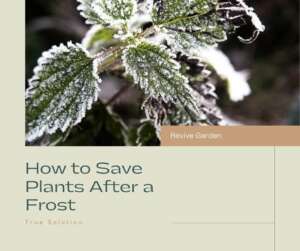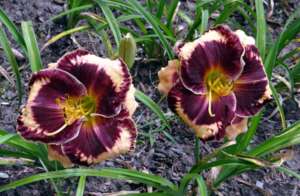Table of Contents
 It’s the middle of spring, and you’ve spent all morning preparing your garden for summer. Your plants look good, and you’re unsure if it’s because you’re more confident in your green thumb this year or if your plants look better.
It’s the middle of spring, and you’ve spent all morning preparing your garden for summer. Your plants look good, and you’re unsure if it’s because you’re more confident in your green thumb this year or if your plants look better.
After all that hard work, a cold snap hits at night. Frost settles on all your outdoor plants and kills them within hours. Fortunately, while frost can kill many outdoor plants outright, the only thing that comes to mind is how to save plants after frost. So, we are here with sufficient answers.
Learn how to save plants after a frost and tackle the common issue of transplant shock with our guide on “How Long Does Transplant Shock Last?
How to Save Plants After a Frost? -Wait and Watch

Plants need to be protected from frosts and freeze. Frosts are better than freezes because they happen overnight when the plants are not exposed to the coldest temperatures.
If you are growing vegetables in containers, move them into a partially shaded location or bring them indoors before the temperature drops below 40 degrees Fahrenheit.
If the plants are already out of the ground, try to move them as soon as possible. If they cannot force it immediately, cover them with blankets or sheets until you can move them into a protected area.
When you move your plants indoors, ensure they do not get too warm immediately; otherwise, they may go into shock and die.
If you cannot bring your plants inside for any reason, you will have to rely on some other method of frost protection, such as windbreaks, row covers, and cold frames.
Help Your Frosted Plants – Step By Step Guide
When plants are exposed to frost, their tissues can be damaged or killed due to the formation of ice crystals within the plant cells. However, not all plants are equally susceptible to frost damage. Some are hardier and can withstand colder temperatures, while others are more sensitive. If your plants have experienced a frost event, here are some steps you can take to help save them:

- Assess the Damage: After the frost, take some time to inspect your plants to see how extensive the damage is. Look for blackened or wilted leaves, water-soaked stems, and other signs of frost damage.
- Don’t Prune Immediately: While it may be tempting to prune away the damaged parts right away, hold off on pruning until the temperatures rise above freezing for a sustained period. Pruning too early might remove live tissue that can eventually recover.
- Watering: If the soil is dry and not frozen, water the affected plants lightly. Moist soil retains heat better than dry soil, which can provide some protection to the roots. However, do not overwater, as waterlogged soil can lead to additional stress on the plant.
- Cover the Plants: Before the next frost, if possible, cover the plants with blankets, sheets, burlap, or frost cloth in the evening. This covering can trap the heat from the ground and provide a few degrees of protection. Ensure the covers don’t touch the foliage directly, which can cause additional damage.
- Mulching: Apply a layer of mulch around the base of the plants. Mulch helps insulate the soil and protects the roots from extreme temperature fluctuations.
- Spray with Water: On nights when frost is predicted, consider spraying a fine water mist on the plants before the temperatures drop. As the water freezes, it releases a small amount of heat, which can help protect the plant tissues.
- Move Potted Plants: If you have potted plants, move them indoors or to a more sheltered location during cold nights. Indoors, they will be better protected from frost.
- Wait and Observe: Give your plants time to recover After the frost event. Sometimes, plants can surprise you with their resilience, and new growth may emerge from seemingly damaged parts.
- Pruning Damaged Parts: Once the danger of frost has passed and new growth has started to emerge, you can carefully prune away the dead and damaged parts of the plant. Use sharp, clean tools to make precise cuts, avoiding further injury to the plant.
- Fertilize and Care: After the frost event, consider fertilizing your plants with a balanced fertilizer to encourage new growth and overall health. Continue regular care practices, such as watering, weeding, and providing appropriate sunlight.
You can also check out our guide on how often to water basil plants for essential tips and care advice.
What Plants Are Most Affected By Frost?
Here’s a chart listing some common plants that are particularly sensitive to frost and the reasons why they are affected the most:
| Plant Name | Reason for Sensitivity to Frost |
| Tomatoes | Susceptible to cold damage; tender, frost-sensitive stems and leaves. |
| Basil | Frost-sensitive herb; can be damaged even in light frosts. |
| Impatiens | Tender annuals; frost can cause wilting and blackening of leaves. |
| Begonias | Frost-sensitive; can suffer from cold damage or die in freezing temperatures. |
| Petunias | Tender annuals; frost can cause wilting and browning of leaves and flowers. |
| Coleus | Sensitive to cold; leaves may become discolored or drop in freezing temperatures. |
| Geraniums | Tender perennials; can be damaged by frost, leading to wilting and leaf discoloration. |
| Fuchsias | Frost-sensitive; can suffer from cold damage or die in freezing temperatures. |
| Cucumbers | Sensitive to frost; vines and leaves may be damaged by freezing temperatures. |
| Squash | Tender annuals; frost can cause wilting and browning of leaves and fruits. |
Can Plants Recover From Frost Damage?
Yes, many plants can recover from frost damage, depending on the severity of the frost and the resilience of the plant species. Frost damage occurs when ice crystals form within the plant tissues, causing cell walls to rupture and leading to visible signs of injury such as wilting, browning, or blackening of leaves and stems. However, plants have some remarkable mechanisms that can help them recover from frost damage:
- Regrowth from Unharmed Tissues: In some cases, plants can recover by producing new growth from tissues not severely damaged by the frost. Once temperatures rise and the environment becomes more favorable, the plant may initiate new growth from buds or nodes located on branches or stems unaffected by the frost.
- Root Recovery: The roots of many plants are often more cold-hardy than the above-ground parts. The roots can remain intact and recover if the frost damage is limited to the foliage and stems. The healthier the root system, the better the chances of recovery for the entire plant.
- Hardy Species Adaptation: Some plant species have evolved to be more tolerant of frost and can recover relatively quickly, even after severe damage. These hardy plants may have special protective mechanisms, such as antifreeze proteins, that help them survive freezing temperatures.
- Secondary Growth: After a frost event, the damaged parts of the plant may be pruned away to stimulate new growth. Removing the dead and injured tissues allows the plant to focus its resources on producing healthy new shoots.
- Protection from the Environment: Protecting plants during frost events can significantly improve their chances of recovery. Techniques such as covering plants, using mulch, or spraying with water can help shield them from extreme cold and reduce frost damage.
- Frost-Tolerant Growth Habit: Some plants have a growth habit that allows them to recover from frost damage more easily. For example, certain perennial plants can go dormant during the winter and regrow from their underground root systems once conditions improve.
Learn more about identifying ginger plants and their appearance by checking out our article what does a ginger plant look like?
Conclusion
Here is some final advice: it’s always better to prepare for a frost than try to repair the damage afterward. The tips outlined in this article are useful but not foolproof, so take care of your garden by covering your plants before night falls.
If you’re still worried about frost damage despite taking precautions, try investing in a weather station that monitors temperature and humidity levels around your home.
With one of these systems installed near your garden area, you can be certain when cold air is approaching and ensure you have time to cover up or move plants indoors before any frost happens on the ground outside!
Also See: Which Plants Do Not Like Coffee Grounds?

